The Land Of Dracula: Is Romania Worth Visiting?
Disclaimer: Some links on this page may be affiliate links. If you purchase anything through them, I will receive a small commission at no extra cost to you! Further details in the Privacy Policy.
Introduction
After heading north from Bulgaria, I hit a mini milestone. Country number 50 on my journey to visit every country in the world. I wanted to find out if Romania was worth visiting, and given where I was, Romania would be the logical next stop.
After all, this is a land with a lot of interesting features. It is home to Transylvania and the story of Count Dracula. It is also infamous for a bleak period of communism under notorious dictator Nicolae Ceausescu.
Not to mention the snow-capped mountains and wild bears here.
Read on if you would like to find out a few of the logistics of visiting Romania, as well as what you can see and do here.
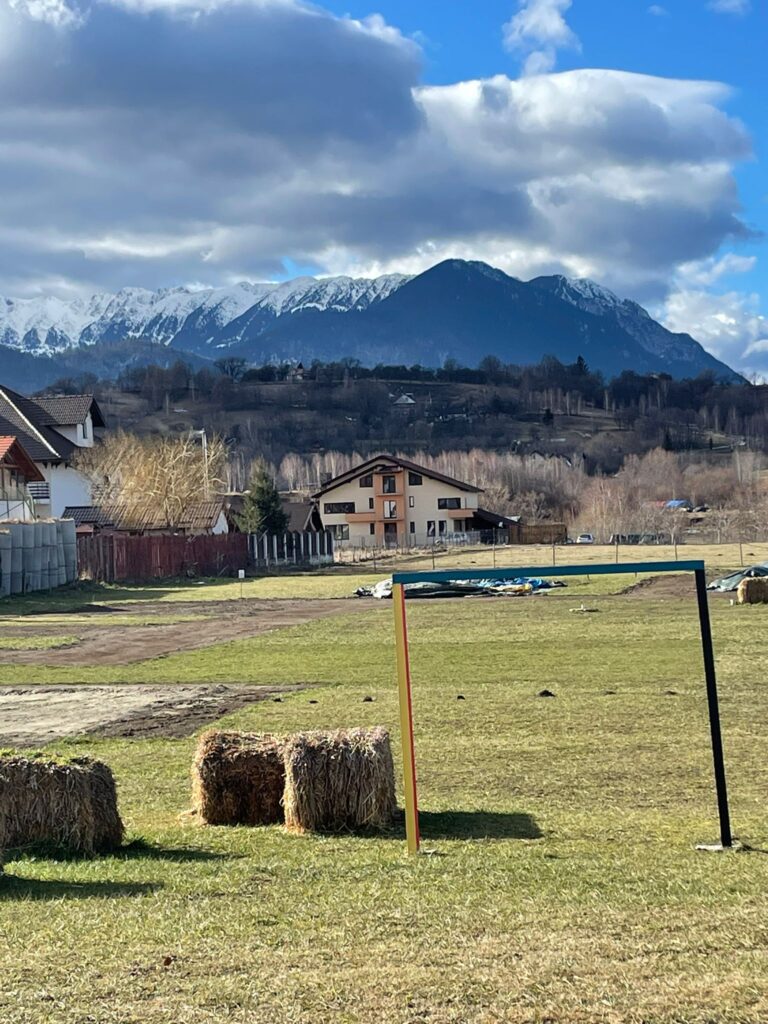
Background on Romania
Positioned in the Heart of Communist Europe
Romania was a country in a unique position. Despite very much being a communist country, and member of the Eastern Bloc, it never became a part of either of the two major communist nations next door.
On the west side was Yugoslavia, made up of seven modern countries: Slovenia, Croatia, Bosnia Herzegovina, Montenegro, Kosovo, Serbia and North Macedonia. The state, officially the Socialist Federal Republic of Yugoslavia (SFRY), was the second biggest communist nation in Europe.
To the east of Romania was the biggest communist country, the Soviet Union (USSR). Latvia, Lithuania, Estonia, Belarus, Ukraine, Moldova, Russia and the eight Caucasus and Central Asian countries made up this 20th century superpower.
With neighbours Bulgaria falling under the spell of communism, it was inevitable that Romania would fall under the same influences. Sure enough, Romania became communist in 1947. Fellow neighbours Hungary followed two years later.
The Ceausescu Years
Some people become famous, pass away, and their memory lives on for decades or even centuries.
Einstein, Isaac Newton and Shakespeare are amongst the names to stand the test of time, retaining a positive influence.
Some individuals aren’t known for such positive impacts however.
Stalin, Hitler and Enver Hoxha were amongst Europe’s most evil statesmen. Names remembered decades after passing, for the atrocities they caused. And Romania could add its own name to the list: Nicolae Ceausescu.
Ceausescu’s Reign of Terror
The sinister socialist rose to power in 1965 after infighting involving other contenders led to him being voted in as the compromise candidate.
He immediately declared Romania a socialist republic, renamed his party the Communist Party of Romania, and set about making Romania a truly miserable place to live.
One of his most infamous moves was to seize property from landowners. Everyone who had worked for years to build a better life for their family was forced to give it up instantly and live in depressing brutalist apartment blocks, all in the name of equality.
Ceausescu ramped up property seizures around Dealul Spirii, a hill in the most earthquake-resistant part of Bucharest. There was a reason for this. He wanted to build one of the world’s largest buildings as part of his North-Korea-inspired cult of personality. The Palace of the Parliament did indeed turn out to be the second-largest administrative building in the world, behind the Pentagon in the USA. It took until 2021 to knock Ceausescu’s creation down to third place. The Sappaya-Sapasathan in Thailand is now larger.
Even today the palace is not finished. Despite having nuclear bunkers deep below the property, there are hundreds of incomplete rooms.
The Dictator’s Downfall
Ceausescu’s reign of terror came crashing down in 1989 after years of economic mismanagement and crippling foreign debts plunged Romania into poverty. A week before Christmas, Ceausescu gave a speech in Timisoara and was greeted with hostility by large crowds, something which caught him by surprise.
By the following day, rebellion had spread all across the country. Reported deaths were around the 1,000 mark as the tyrant tried desperately to cling to power. The dictator tried in vain to give another speech in Bucharest. Yet riots broke out, and Ceausescu fled with his wife Elena and some close associates via helicopter.
The walls were closing in. They fled to Snagov, then Targoviste. In the latter, the army who turned on him ordered the helicopter to land.
On December 25th, Ceausescu and his wife were charged by a kangaroo court with multiple crimes including genocide. They were found guilty within two hours, and executed in the courtyard outside the courtroom.
Celebrations broke out across the country as news spread, and 1989 turned out to be a very merry Christmas for the people of Romania.
Gotta love a happy ending.
Post-Communist Romania
The National Salvation Front took charge of Romania after the revolution, and installed a series of democratic reforms.
Romania increasingly distanced itself from the east, and cosied up to the west, becoming a NATO member in 2004. It also applied to join the EU and was successful three years later.
Romania has since become a safe and stable nation. It lacks the economic prosperity of many of its western allies, yet has grown significantly since the dark days of the Eastern Bloc. Despite this, Romania loses a lot of workers, attracted to western countries by higher wages and the lure of a better lifestyle.
Modern Romania has shaken off its image of a bleak communist nation. Instead it attracts tourists for its stunning mountains, and castles, most notably those related to the story of Count Dracula. Ironically, author Bram Stoker never stepped foot in Romania, yet his Transylvania-based tales have become a global hit regardless, and given the country’s image a boost. Although Vlad the Impaler, a bloodthirsty ruler who Dracula was based on, was not known for such positive reasons.
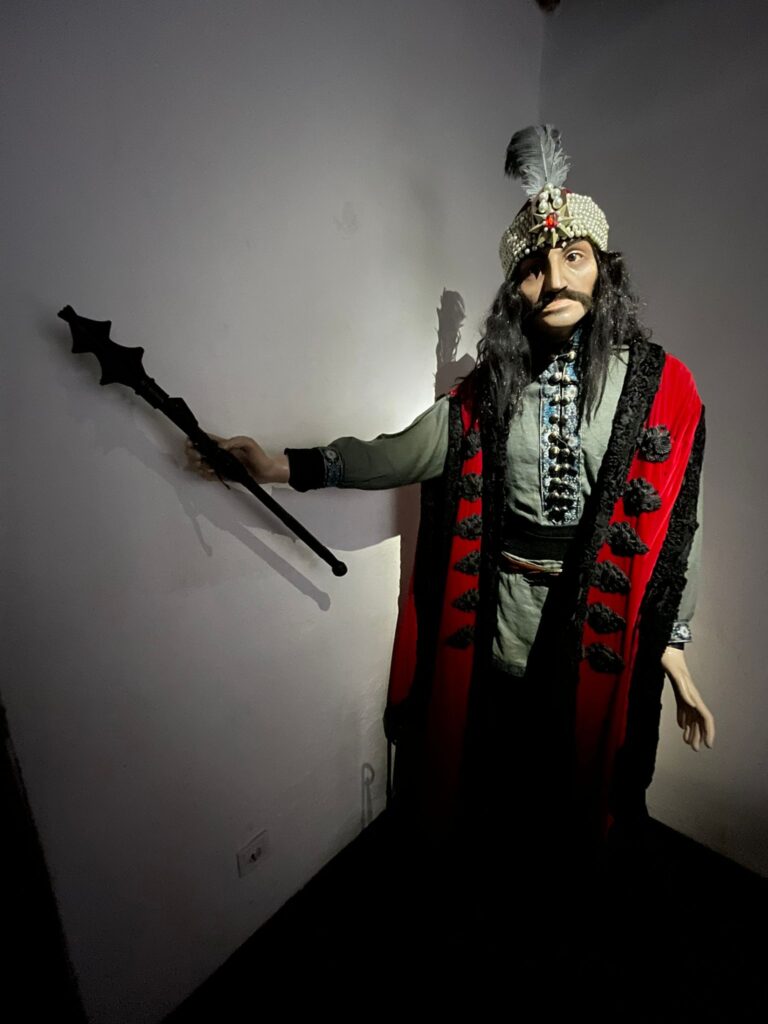
Is Romania Safe to Visit?
Yes. Violent crime is incredibly rare here. The only crime which you should be wary of here is pickpocketing. Mostly in the big cities and around transport hubs.
Perhaps the main danger in Romania comes from animals. Stray dogs are common and should be avoided at all costs. Bears are a problem more unique to Romania, as they are fairly common in rural areas, and can often come to cities where there are forest areas nearby.
If you see a bear, don’t run. Instead back away slowly and avoid eye contact with it. Be especially wary if you see bear cubs, as the mother is probably nearby and will be a lot more aggressive than a lone bear.
Oh, and don’t worry about vampires! Fortunately, Transylvania’s most famous residents won’t be swooping down whilst you sleep.
When is the Best Time to Visit Romania?
As with much of Europe, the best time to visit Romania is during the warmer summer months. The better weather generally lasts from around April-October time.
Unlike neighbouring Bulgaria, Romania doesn’t attract big summer crowds to its Black Sea coastline. Therefore you won’t see much of a spike in costs here. Prices are generally consistent year-round.
Winter however is better if you don’t mind the cold, and have more of an interest in the history and culture. Whilst Romania isn’t a country with heavy tourist traffic, it is quieter in the winter months from October-April time.
How to Visit Romania
Romania’s visa policy is the same as that for the entire Schengen Area, despite Romania not yet being a Schengen member. They are one of four EU countries, alongside Ireland, Cyprus and Bulgaria, who are not in Schengen. Although they (and Bulgaria) hope to change this soon having started the joining process.
Residents of almost every European country can enter Romania without a visa. There are exceptions for Kosovo, Russia and Belarus.
Residents of all countries in the mainland Americas can also come in visa-free, excluding Belize, Ecuador, Bolivia, Guyana and Suriname.
Residents of almost every other country require a visa to enter Romania. Japan, South Korea, Taiwan, Malaysia, Australia, New Zealand and the UAE are notable exceptions in a list otherwise full of smaller countries, mostly islands.
How to get to Romania
Romania’s biggest airport is Henri Coanda (Otopeni) in Bucharest, IATA code: OTP. This airport serves most of Europe, as well as Egypt, Lebanon, Israel, Jordan, Saudi Arabia, Qatar and the UAE.
Other key cities with international airports include Brasov, Timisoara and Cluj.
Romania is a very easy country to get to, with buses and trains connecting it with many other countries around Europe. Trains in Romania and surrounding countries are notoriously slow, and still have a very “Eastern Bloc” feel to them. The train from Bucharest to Chisinau in Moldova for example takes 14 hours, three of which are spent waiting for the wheels to be changed. This is because Romania and Moldova have different-sized tracks.
How to get Around in Romania
Buses and trains are common across Romania, and very affordable. The other common form of transport here is minivans, which generally leave when full rather than sticking to a set schedule. They can often be the best option for getting to more remote parts of the country.
Is Romania Cheap to Visit?
Romania is a very cheap country to visit. I got by on £26 ($33) per day here, staying in hostels, travelling by bus, and still having spare change for activities (which are very cheap).
You can find street food in Romania for just £2-3 ($3-4). Accommodation starts from £6 ($8) for a hostel bed in Bucharest. Private rooms from roughly double that.
Activities rarely cost more than £5-10 ($7-14) in Romania. Of course, this varies wildly depending on what you do. But for standard tourist attractions, and sports matches, this is the rough cost.
Transport is a little more expensive. Expect a long-distance bus journey to cost around £20-30 ($25-38).
Where is Worth Visiting in Romania?
Romania isn’t short of places worth visiting. I can only talk of places I actually visited however. After all, this blog is based on authentic experiences. Therefore without further ado, let me take you through what I saw in Romania and whether or not it’s worth visiting.
Bucharest
Stop number one was the capital. I got off the bus and walked towards the centre. After a long time walking through the gloomy streets between the bus station and city centre, I came across the city’s free walking tour.
When I’m in a new country, or even a new city, one of my first things on the to-do list is a free walking tour.
These tours involve a local taking you around their home city for 2-3 hours giving you a detailed insight into the history, culture, and some of the most interesting places you can see.
Free Walking Tour
Despite still having my heavy bags and not quite making it to my accommodation first, I went ahead with the walking tour. Here are some of the stops along the way:
Palace of the Parliament
Our local guide started by taking us to the Palace of the Parliament. She told us a lot about the palace, why it was built, and the Ceausescu years. In fact most of the history I wrote about earlier in this article is based on what she told us.
The size of the palace is impressive. The aesthetics not so much. Communists were never known for good taste. The bleak grey skies were a fitting setting for this equally gloomy building.
It’s the biggest (quite literally) attraction in Romania and well worth checking out, if only to learn about the history of the place.

Gloomy Communist Apartment Blocks
We later passed many gloomy apartment blocks. Home to the locals after property had been seized. The communists preached equality, and they sure got what they wanted. Almost everyone was equally poor and miserable in pre-1989 Romania. They lived in squalid rooms with minimal facilities.

The CEC Bank
Not every building was ugly however. The CEC Bank is an example of traditional European architecture with an impressive dome on top, and a style that wouldn’t look out of place in Budapest. The Hungarian capital is famous for its stunning buildings. And the CEC Bank looks just like the type of structure you may find alongside the banks of the River Danube.
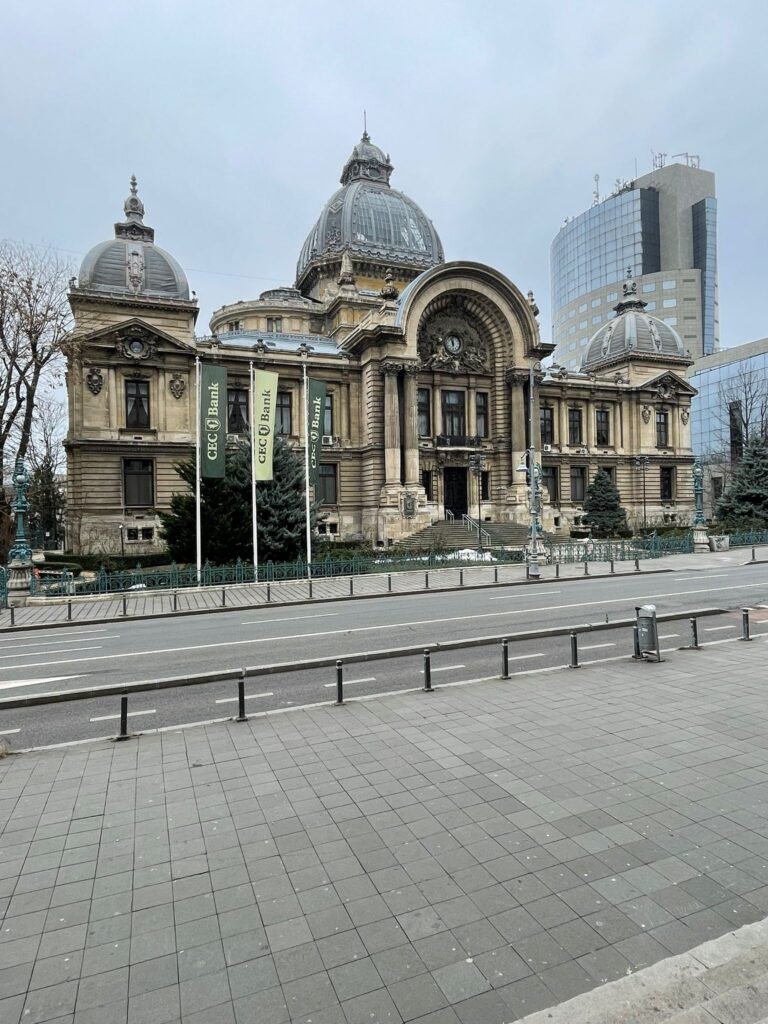
Parisian Parallels
The CEC Bank stands opposite some streets with a more Parisian look to them. Bucharest is often likened to the French capital. And it’s easy to see why. The architecture is one reason, but Romania also has a bit of a cafe culture, the outdoor dining spots are also reminiscent of restaurants in Paris. And other parts of mainland western/southern Europe to be fair.
If you like Paris, you will probably like Bucharest.
Although I would say that Argentina’s Cafe Tortoni is the most Parisian cafe I have visited outside of Paris.
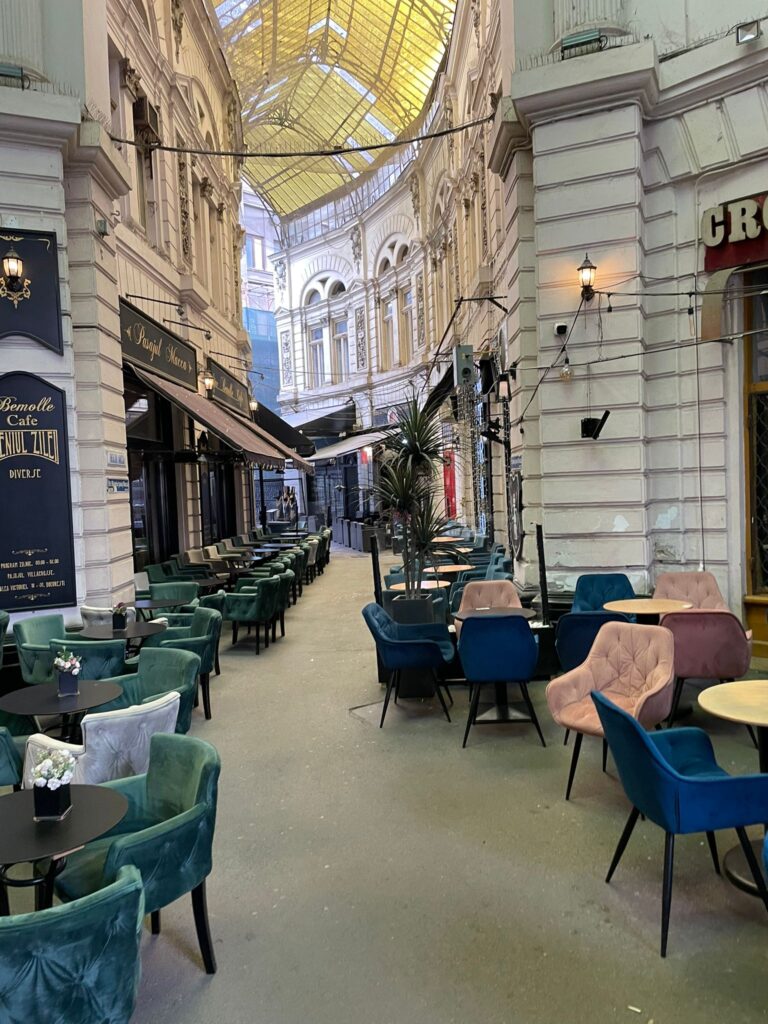
Carturesti Carusel
One popular stop on the tour is Carturesti Carusel. This bookstore has earned a reputation as one of the most famous in the world. As with many elegant buildings, it was seized during the communist era, and left to rot for many years. The grandson of the original owner won the building back in 2007 after a lengthy court battle, and turned it into one of the best Instagram spots in Bucharest. If you’re able to tolerate the high tourist numbers that is…
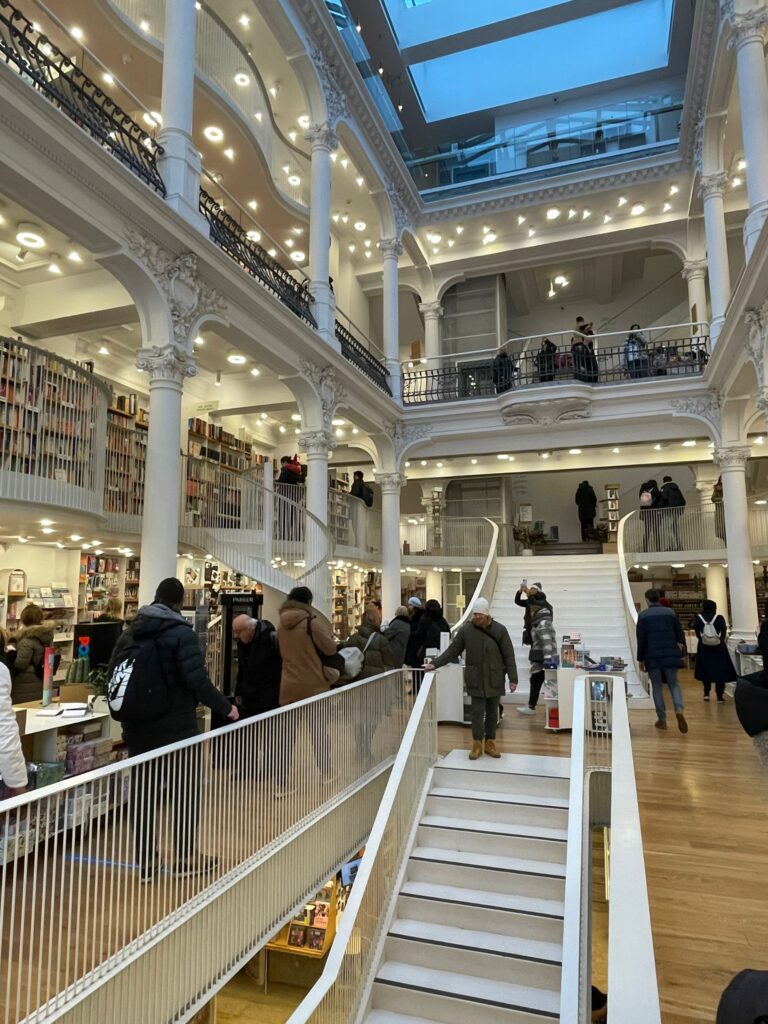
St. George Orthodox Church (The Hand of Santa Claus)
An interesting place in Bucharest is the St. George Orthodox Church. This is home to the hand of a rather famous figure. Saint Nicholas, yes Santa Claus, was famous for his generosity. Hence how the tradition of Santa Claus began. His body parts were sent to various churches across Europe, and his hand can be found here, preserved inside a casing to protect it from damage.
The walking tour takes you through many of the city’s highlights, as well as being a great place to learn the history straight from a local. It is well worth your time.
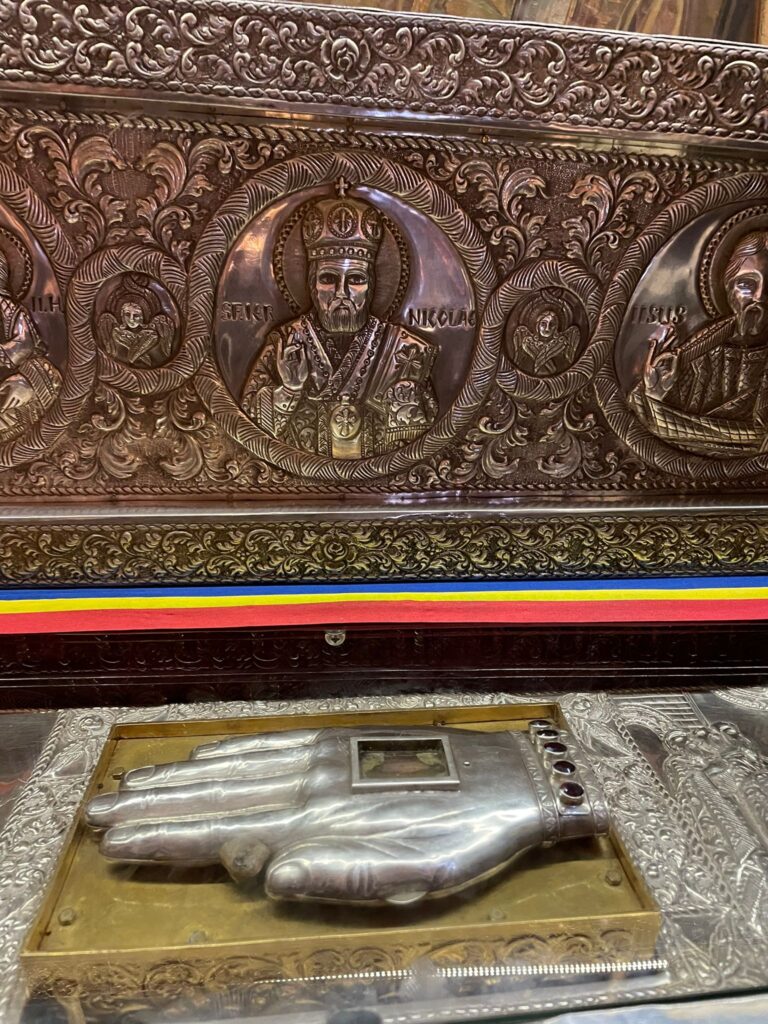
Football in Romania
As an avid football fan, I aim to attend a top-level game in every country. This can be a top-flight league match, a cup competition that top-flight teams compete in, a continental competition (such as Champions/Europa League) or an international match.
In Romania, the aim was to continue this streak, and so I did.
Romania’s biggest club by far is Steaua Bucharest. If you know of one team from Romania, it will be them. However, things have become messy in recent years for the Romanian giants, best known for toppling Barcelona to win the European Cup (now Champions League) in 1986.
In 2017 it was deemed that owner George Becali’s 2003 purchase of the club from the government was invalid. Steaua lost the rights to the Steaua Bucharest brand, and rebranded as FCSB. A splinter club formed as Steaua Bucharest in the fourth division, and a bitter rivalry has formed between the two who both claim to be the original Steaua Bucharest.
For English football fans, the closest comparison point would be the AFC Wimbledon/MK Dons situation.
Anyway, whilst the identity of the real “Steaua Bucharest” is up for debate, I saw one of the two teams in action, namely FCSB.
They played away to another Bucharest team, FC Voluntari, and won 2-1 on a freezing February evening. The ticket cost £5/$7 on the gate, and the visiting fans made a lot of noise. Definitely good value for money seeing this one.
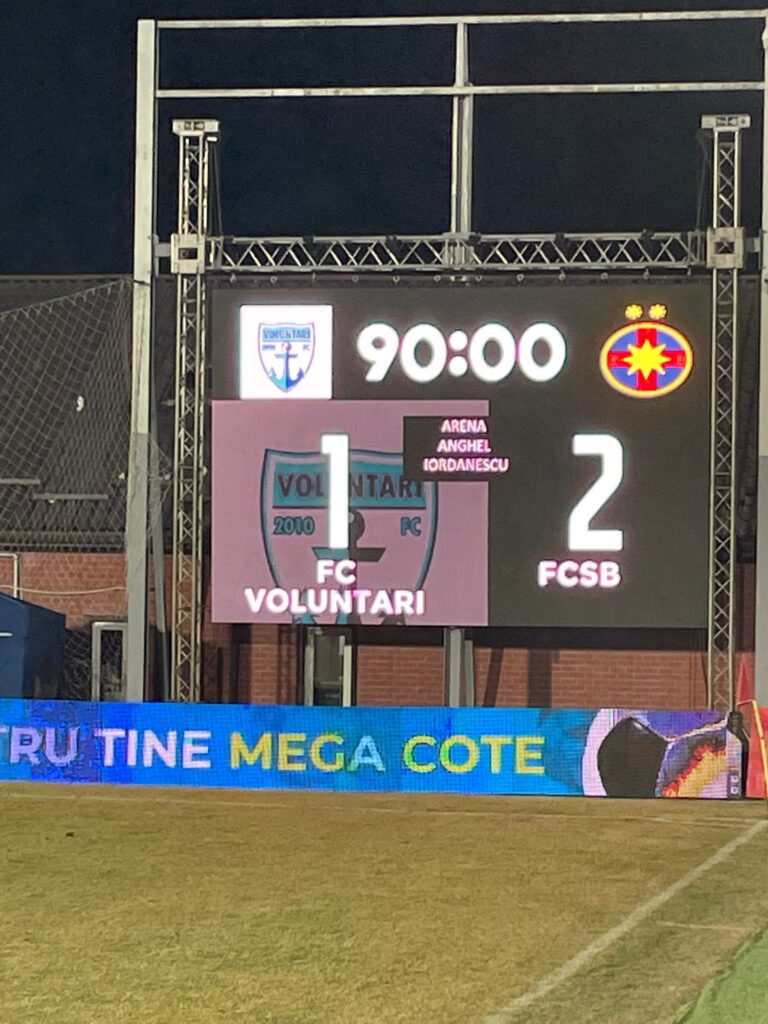
Brasov
After Bucharest, I spent a few days in fascinating Moldova, which included a trip to one of Europe’s most interesting territories: Transnistria. But I had unfinished business in Romania. It was time to head back, and the first stop on my return was Brasov.

This medieval city is known for its colourful buildings which make it a popular Instagram spot amongst youngsters today…
However, you don’t need to be a budding influencer to appreciate this city’s charm. Iconic Piata Sfatului is the main square, and a hive of activity throughout the day. The aforementioned colourful buildings can be seen all around the edges of the square, whilst an impressive city hall stands at the heart of the square, having initially been built around 800 years ago. A great place to grab a bite to eat, or just watch the world go by.

A few seconds away from the square is one of Brasov’s other popular attractions: Biserica Neagra. Eastern Europe’s largest gothic church earns its name (“Black Church” in English) from the fact it was damaged by a fire in 1689. The smoke from the fire burnt the walls, and the Black Church has been known as such ever since.
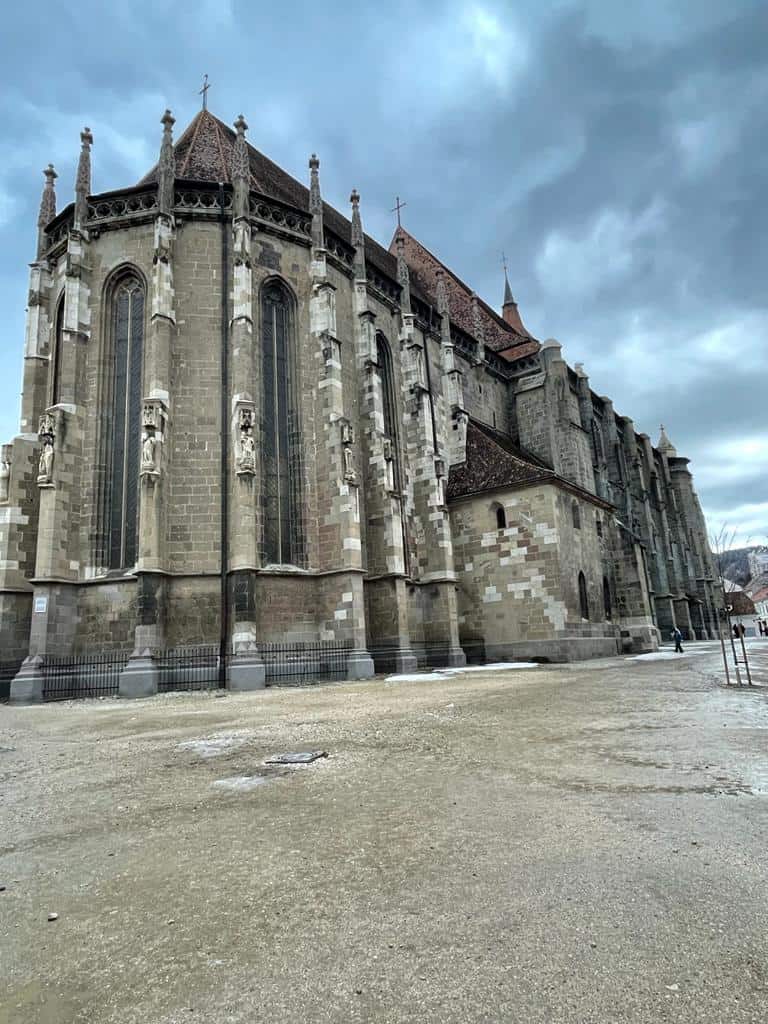
Brasov is certainly a place worth visiting in Romania. It even has a large Hollywood-style “Brasov” sign up on Tampa Mountain, which overlooks the city. It is possible to hike up the mountain, which should take around an hour or so. There are also cablecar options if you don’t fancy walking.

Brasov is a great place to spend two days in Romania. Perhaps longer if you wish to do some day trips.
Speaking of day trips…
Bran Castle
One of Romania’s most famous places is Bran Castle. This is because it has been attributed to the iconic story of Count Dracula. In fact because of this, it earns the nickname “Dracula’s Castle”. Many people believe this is one of the places most worth visiting in Romania because of the Dracula links. However, it actually doesn’t have many connections with the fictional vampire at all..

Bram Stoker, the author of “Dracula”, never went to Transylvania, or even Romania at all. His character was loosely based on Romanian villain Vlad Tepes, most commonly known as Vlad the Impaler. Tepes was an ex-ruler of Romania, infamous for executing his enemies by driving a wooden stake through their bodies, and rumoured to drink their blood as they lay dying. This rather disturbing act was never confirmed to be true.
Vlad the Impaler’s father was called Vlad Dracul, perhaps another link that led to Stoker naming his character Dracula.
And Vlad allegedly never even went to Bran Castle. Some rumours emerged that he was imprisoned there at some point. However, these have never been confirmed to be true.
Therefore if Bran Castle had little to do with Bram Stoker, Vlad the Impaler or Count Dracula, what could you find there?
It was once the home of Romania’s Queen Marie. You can see many of her belongings and rooms which have been preserved. She lived there from 1920-1948 which is when the property was seized by the communists.
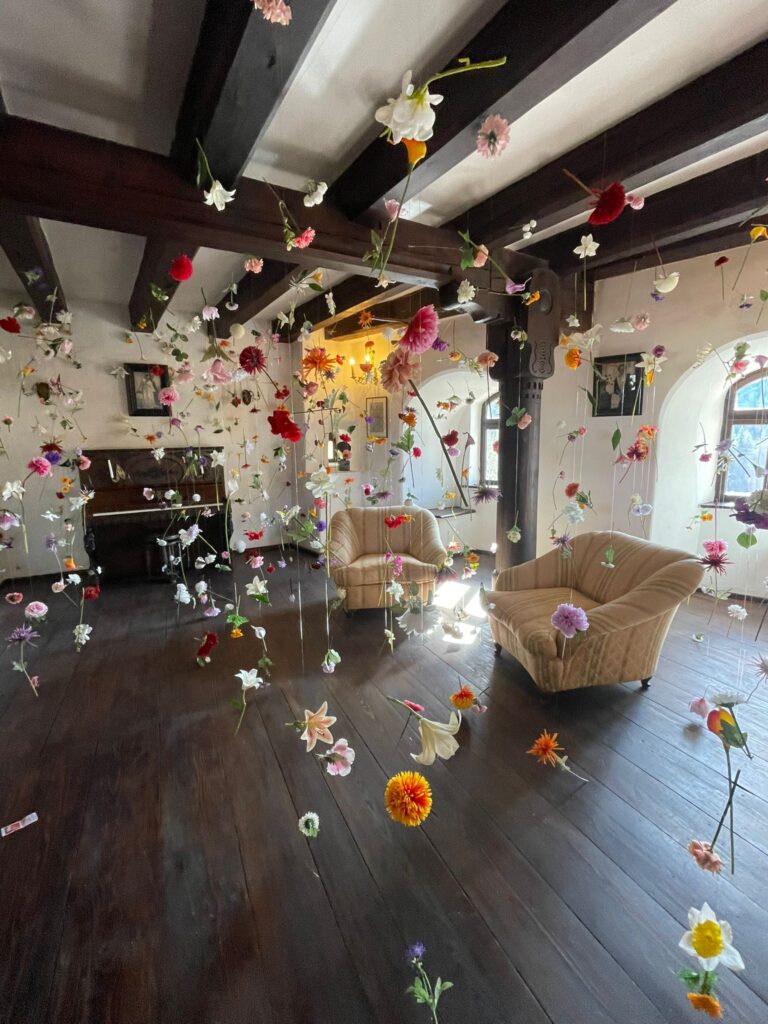
If you want to visit Bran Castle to learn about Queen Marie, it is certainly a location within Romania that’s worth visiting. If you want to learn about Dracula, you’ll be disappointed. There is a tiny section touching on Count Dracula, Vlad Tepes and Romanian mythology. But the Dracula connections are very limited.
Another popular daytrip is to Peles Castle. Whilst I never went here, people who have been generally prefer it to Bran Castle. It is said to be more beautiful than Bran Castle. Unlike Bran, there has been no attempt to connect it to Count Dracula.
Timisoara
This small city near the Serbian border draws a lot of parallels with Brasov. It has a small square (Union Square) and many colourful buildings dotted around.

One of the most famous is Casa Bruck, which has hosted a pharmacy since 1898. It draws attention due to the colourful building combined with its unusual shape.
Also popular here is the Orthodox Cathedral. Apparently it is known for its golden interior. Although the terrible weather during my time in Timisoara dissuaded me from exploring. Therefore I didn’t quite make it inside here, or to anywhere beyond what I’ve just mentioned.
Where to Stay in Romania
As always I will only mention places I have actually stayed in. Therefore this isn’t a list of “best hotels in Romania”. Rather, it’s an honest opinion of each location I stayed in. These may be good, bad or indifferent options.
Bucharest – Sleep Inn Hostel (£12/$15 Per Night)
Pros
Reasonable location in central Bucharest. The wifi also worked well here. On top of that they had warm (albeit very small) showers. Lockers were also a good size to store your bags.
Cons
Arguably the rudest staff I’ve ever come across in 150+ hostels. One particular man on reception was a perfect example of how not to be in a public-facing job. He claimed the hostel could do my laundry for a set price. Great. Then he later decided against it because he couldn’t be bothered.
The same member of staff was playing loud (c)rap music and videos in the common area on full blast for everyone to hear. I also heard him mocking other guests. At one point a girl called to cancel her reservation, and the man gave her a lot of attitude before calling her “stupid”. This was right in front of myself and other guests. He didn’t seem to care.
Overall
Ignoring the staff, this place was probably a 7/10. It had basic facilities without having anything spectacular. There was no breakfast option, but it was clean enough and not too expensive. Not overly keen on returning though.
Brasov – Centrum House Hostel (£14/$18 Per Night)
Pros
Great location in the city centre, and very quiet. The wifi works well here and the staff are friendly and helpful. They let me stay for several hours after the checkout time since it was quiet.
Cons
There wasn’t any soap in the majority of bathrooms. They didn’t do a great job of restocking.
Overall
Lovely little hostel to stay in, was certainly satisfied with my stay here and would definitely go back. It perhaps isn’t the most sociable hostel, but there is at least an open area in reception where you can meet others. Although this is in a different building to the bedrooms. Would rate this a solid 9/10. Good place.
Timisoara – Mosaico Alfetta Hostel (£10/$13 Per Night)
I stayed in a private room for £17/$21 per night. Therefore this deviates from my usual travel style of staying in hostels. In some ways, paying a bit more for a private room raises expectations. Therefore the service must be higher to ensure a high rating on the booking websites. The more you pay, the more you expect.
Pros
The owner was incredibly friendly and helpful. He gave me a map and showed me everywhere worth visiting in Timisoara. It was very warm and quiet in here, the wifi worked well, and there was a lovely croissant with a coffee for breakfast. The owner also arranged my shuttlebus transport to Belgrade.
Cons
I arrived early in the morning on an overnight bus and went here a few hours before checkin with the hope of being able to offload my bags, and hang out in the common area before the room was ready. Unfortunately this was not possible.
Overall
A wonderful place to stay with a very homely feel to it. Would absolutely go back here if I returned to Timisoara in the future. A 10/10 accommodation for me.
Final Thoughts: Is Romania Worth Visiting?
In all honesty, Romania underwhelmed a little. Perhaps it was a victim of high expectations. However the question here is not about my personal experiences, it is about whether or not Romania is worth visiting. And the answer is yes. Romania has a lot to offer. The Carpathian Mountains, the Black Sea, medieval castles, beautiful buildings, a fascinating history, and more.
Perhaps the biggest mistake I made was going in freezing February. Some destinations such as the Carpathians and Black Sea were never on the agenda due to the cold weather.
Romania is worth visiting not just for these diverse sites, but also the fact it is ultra affordable. Your money will go much further in Romania than it would in the west.
Bran Castle will disappoint if you go looking for Dracula, but everywhere else comes with a lot of positives.
As with any country, perhaps the best thing to do is to check out the destination yourself.
Thanks for reading if you made it this far. Check out my destinations page for more tips, advice and stories from my journey to visit every country in the world.


Love it
Thank you!